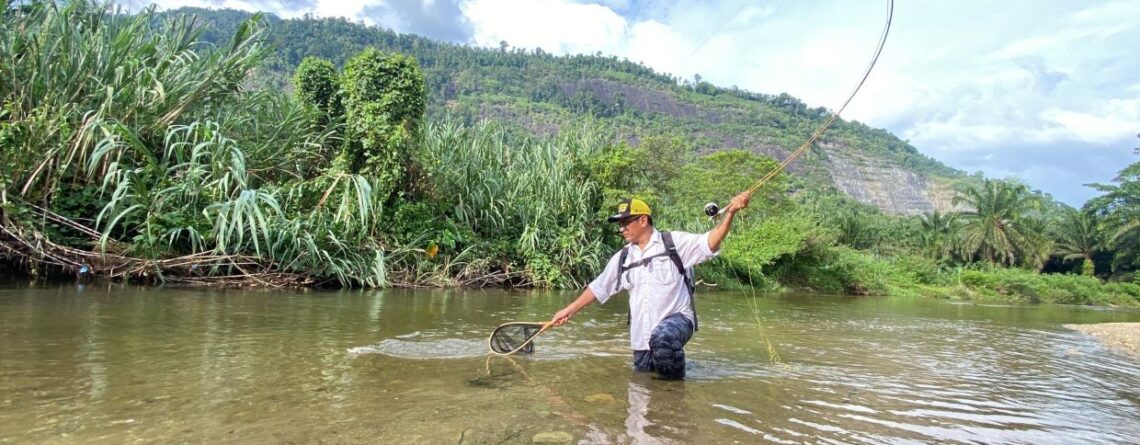Pristine rivers in half-forgotten Malaysian towns offer a unique experience
Small towns around the world can become “victims” of progress when highways are built.
As traffic zooms along the highways and bypass old trunk roads, small towns lose economic opportunities.
But when something is lost, something else is gained.
The tin-mining towns of Kampar and Gopeng in Perak are testimony to this fate when the North-South Expressway stretch between Kuala Lumpur and Ipoh was completed in the early 1980s and the metal suffered a global drop in demand.
These towns are not sleepy backwaters because back in the 60s and 70s, they were developing rapidly, so there was much public infrastructure and amenities in place.

When growth slowed down, the rewards are nature conservation and a rustic tranquillity that is not quite rural and more akin to a suburban lifestyle.
This special twist creates an eco-tourism potential that is rare in Malaysia.
Sungai Kampar is one of the few pristine places in the country where sport anglers can wade into the river to fish.
Wading in clear, shallow water with sandy riverbeds while fishing is a unique pleasure.
Swims, eddies and bends with riverbanks choked with overgrowth become reachable.

More importantly, this style of river fishing allows you to target fish that tend to be rare, and examples are the tengas (copper mahseer), lampam sungai (tinfoil barb), sebarau (Hampala barb) and sikang (Malayan trout).
The advantage in Sungai Kampar is that you do not have to slog for hours through a jungle like in Taman Negara, Pahang, to experience this style of fishing.
Just drive 10 minutes out of Kampar town (with many modern hotels there to choose from) and the next thing is that you are standing in the middle of the river wetting your line.
To see the spot for yourself, point your navigation app to Jambatan Kampung Kuala Dipang, itself a WWII historic site where British-Malayan troops fought a fierce battle against Japanese forces to hold the bridge.
The water is cold, which is a blessing when you are fishing under the burning afternoon tropical sun.
The river is knee- to waist-deep and the river bed is just coarse sand – no yucky mud.

There are neither large settlements nor industrial activity upriver all the way to the river’s source in the Titiwangsa mountain range, but you should still refrain from swimming outright to avoid pathogens and wear a lightweight life vest if you don’t know how to swim.
In the rainy season now, Sungai Kampar will tend to be somewhat turbid (a translucent yellow) and with the larger water volume, the main outdoor activity is whitewater rafting and even riverboarding far upriver at the foothills.
From the middle of next month to March, considered as the dry phase of the North-East Monsoon, Sungai Kampar along the stretch between Gopeng and Kampar becomes docile.
The river depth drops and the water becomes crystal clear.
Anglers, especially fly-fishermen, can then be seen here almost every day.

The top target is the lampam sungai. Native to Malaysian waters, it will swim laterally towards you after you tire it, displaying its gleaming tin-white body with bright red fins and tail to the sun.
“The good news is that this is a common fish that loves to take flies. During spawning, a single female lampam sungai scatters thousands of eggs while many males release sperm simultaneously to fertilise the eggs.
“So our target is a common and plentiful fish that is at the same time shy and careful,” said Perak Fly Fishing Syndicate (PFFS) president Rizal Effendi.
Aquaculture literature on the fish states that a female weighing 200gm to 300gm can hold up to 5,000 eggs.
He said fly-fishermen would wade quietly up or down the river in search of a potential swim about 20m to 30m ahead, and then they begin whipping their rods.

To entice the lampam sungai, use tiny flies tied in the forms of the stonefly, pheasant tail nymph or flash nymph.
These are fast-sinking flies that beat the river current and drop low before fly-fishermen strip the line and get the fly moving in an erratic stop-and-go motion.
Though bony, lampam sungai is renowned for its delicious, sweetish and fatty meat.
Those who catch large ones (about 30cm long) seldom release them because at that size, it is easy to pick out the fine Y bones in the fish’s musculature.
“A good target fish is one that is not a threatened species, is plentiful in a pleasant environment and will present a good challenge for anglers. We consider the lampam sungai an iconic fish in Perak for fly-fishermen,” said Rizal.
But the fish that takes the cake is the sikang.

Its common name is Burmese or Malayan Trout, depending on whether you are in Indochina or Malaysia. Its scientific name is Raiamas guttatus and quite frankly, it is rare.
This beautiful fish was given the name “trout” because it resembles one, though it is not even remotely related to any trout.
“You have to wade along a shallow river to admire it. It likes to lurk in the shallows of less than 30cm deep.
“Its light golden, spotted body camouflages the fish so well with the sandy riverbed,” said PFFS vice-president Hafizal Hazeri.
It earned the name “trout” simply because of its disproportionately wide mouth with a hook-like upturn at the end of the lower jaw, just like a, well, trout.
Hafizal said although delicious, it is bony so many anglers yearn to catch it, photograph it and then release it.

For the uninitiated, lure anglers and fly-fishermen usually hook fish in the mouth, as opposed to anglers who use bait. Bait-fishing is such that fish tend to swallow the offering and become gut-hooked, which is a mortal injury.
Lure anglers and fly-fishermen hold their fishing rods at all times, so they instantly feel every tap or nudge when a fish bites. They then make a quick jerk and set the hook into the fish’s mouth.
There is, perhaps, another aspect of catching the sikang that some anglers will like: you don’t have to get up at ungodly hours to catch them.
This is a fish that is most active in the bright of day when the sun is over your head.
“I think the shadows of flies being worked on the water surface makes the sikang crazy,” laughed Hafizal.
Gurglers and other topwater flies with pronounced “legs” being twitched draw the sikang, stressed Hafizal, even in shallow and open river stretches where you would never expect predatory fish to be holding.
On sandbanks with just 30cm of water where the current is slower, sikang lie in the open, perfectly camouflaged.

The sikang also lurks right below drop-offs, at confluences of rivers or even where canals flow into Sungai Kampar.
“You can try a conservative dry fly, or use a topwater fly with many legs and make it look like an insect that fell on the water and is struggling on the surface.
“But if the water is a little turbid that day, a sinking fly that looks like a baitfish with a little flash might work better,” said Hafizal, adding that green and white are good colours but add a touch of blue because many species of baitfish and tiny shrimp tend to display touches of blue hues underwater.
In reality though, the cardinal rule of exploring a new fishing spot is to always rely on local knowledge and fortunately, PFFS as a registered and not-for-profit society, has appointed four of its founding members as fly-fishing guides.
For a fee of RM100, out of which PFFS usually exacts 20% to fund society activities, outsiders can contact one of the four guides to take groups of up to five anglers to wade along Sungai Kampar.
There are many more things to know, said Hafizal, like how to wade in the river without spooking fish, and even what colours to wear.
“Wading in a river to fish gets you close to where fish are, but you will also be so close that the fish can see you, so you need to learn how to be stealthy,” he said.
Knowing that not all anglers are versed in the art of fly-fishing, he said some anglers do go using ultra-light spinning gear to cast tiny lures and soft plastic grubs to catch fish like sebarau and tengas, rare in their own right.
To find out more, seek out PFFS on its public Facebook group.













Leave a Reply